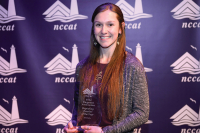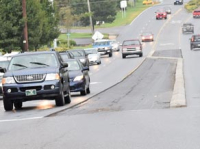Cemeteries ensconced by park remain a source of consternation
 It is a day Lawrence Hyatt looks forward to all year — venturing into the Smokies backcountry to pay homage at the graves of early settlers who lived there.
It is a day Lawrence Hyatt looks forward to all year — venturing into the Smokies backcountry to pay homage at the graves of early settlers who lived there.
But this year, a landslide washed out the only trail leading to Lower Noland Cemetery, a place he’s visited regularly since childhood. The National Park Service, which transports descendents into the park for graveside Decoration Days, postponed the visit from April until October.
According to Hyatt and others who regularly visit cemeteries in the Great Smoky Mountains National Park, that was not the first time a trip has been rescheduled because the park service has not yet taken the time to fix a damaged road.
And during the past few years, it has led some to feel as if park leaders are trying to shut them out of the old cemeteries, which are home to many of their ancestors.
“They seem to be trying to freeze us out,” said Lawrence Hyatt, a native of Swain County who lived with his family in Noland Creek until 1946 when it became part of the Great Smoky Mountains National Park.
Related Items
Hyatt, who now lives in Tennessee, is one of dozens who make an annual pilgrimage across Fontana Lake and venture into the rugged Smokies backcountry to visit the graves of their ancestors. There are more than two dozen family cemeteries dotting the Swain County side of the national park. The graves date to before the national park’s creation, when small communities were scattered through the hills and families tended their own cemeteries.
Family trips to visit the old cemeteries gave rise to the unique tradition known as “Decoration Days.” Each family cemetery has its own scheduled Decoration Day, when flowers and decorations are lavished on the graves. There are picnics, hymns and prayers, a family reunion of sort for descendents.
But the journey into the North Shore region of the national park — the largest roadless area in the East — is a challenge for descendents, especially the older ones. The park service helps out by transporting families across Fontana Lake by boat and up the trails by jeep or four-wheelers where possible.
However, some regular cemetery visitors feel that in recent years, the park service is simply waiting for the groups of older people who still celebrate Decoration Days to dissipate.
“It is just a matter of when the older folks fade out,” said Aileen McCoy, a 65-year-old Bryson City resident. “They would like the whole North Shore thing to go up into wilderness as if no one ever lived there.”
People have complained that the park service does not accommodate more senior citizens who still wish to participate in Decoration Days but are not very mobile. They want the national park to improve the rough trails to give people easier, better access to the cemeteries.
For the baby boomer generation and their parents, Decoration Days are an ingrained tradition. They are something that you must do; participation is not optional. It is what they have always done.
“They are my people, and I pay heritage to them,” Hyatt said. “They are the ones who built the churches and all of that stuff. It is a responsibility.”
Although Hyatt’s people were exhumed from a cemetery that lies under Fontana Lake and reburied at Lauada cemetery in Bryson City, he still likes to visit cemeteries such as Lower Noland. For him and others of his generation, Decoration Days were the highlight of the year, a time to gather, to pray and to celebrate.
“Most of the younger people don’t understand what it meant to these older people. The decoration was the social event of the year,” Hyatt said. “We have people from all walks of life. We have doctors and lawyers and Indian chiefs. And we have poor people, hard working people.”
People would not just go to remember their relatives and decorate their own family’s graves but also those of their ancestors’ neighbors.
“It’s not just a ‘my family’ thing. It’s a whole community thing,” McCoy said.
Obstacles to entry
The negative sentiments toward the park service expressed by McCoy and Hyatt are examples of why the Swain County Board of Commissioners recently established the nine-member National Park Cemeteries Accessibility Council. The hope is the advisory council will give the park service an extra push toward improving access to the cemeteries.
“That is all we are asking for, to provide access to any and all who have people buried up there,” said Swain County Commissioner David Monteith.
In some cases, people have to take boats and hike at least a mile to the now-secluded cemeteries.
There is already an organization, the North Shore Cemetery Association, which works with the national park officials. Monteith said the council is not trying to undercut the existing cemetery association’s efforts but rather add to them.
“We just want to enhance it and make it stronger,” Monteith said. “Try to put more backbone to it.”
The postponement of the Lower Noland cemetery visit seems to be the impetus for the council’s creation. According to Monteith and others, it is just one of a number of incidents when people have had trouble getting to a cemetery site.
Although Decoration Day at Lower Noland will still happen, just in October, some participants complained that the park service could have fixed the dirt trail between January when they washed out and April when the Decoration Day was scheduled — especially since families plan reunions around the graveside gatherings.
Don Casada, who has made it his mission to map the forgotten and historic home sites now hidden among the forests of the national park, visited the Noland Creek area after the slide and was shocked to find the trail still damaged with just some cones setup around the site.
“It was clear that absolutely nothing had been done,” Casada said. “It was kind of really surprising to me that nothing had been done to prevent further erosion.”
Casada sided with critics who believe the park service has slacked on its responsibility and could have fixed the Noland Creek slide in time for Decoration Day or at the very least used four-wheelers to transport people.
“There is plenty of room to take those through there,” Casada said. “If they really wanted to do it, it could be done, in my view, if it was a priority.”
In documents from the 1930s establishing the Great Smoky Mountains National Park, “The tenor of those was the park service would do everything they could,” Casada said. “It does seem to me that in the last few years it has declined significantly.”
Rather than balancing the preservation of the land and the memory of the people who once lived there, the scales tend to be weighed away from remembering what Swain County residents gave up, he said.
“Places are very important to mountain people — home places,” Casada said. “It basically becomes a family reunion.”
But park representatives stated it is simply a case of not enough manpower. The remote trail system along Fontana Lake is not heavily trafficked like U.S. 441 or Deep Creek, both of which experienced slides after January’s rainstorms and flooding.
With limited resources and lots of park trails and roadways, it’s difficult to maintain.
“It’s challenging. There are a lot of challenges with all the roads and networks keeping them going,” said Tobias Miller, a trails supervisor with the park service.
Miller added that park service officials consulted with the North Shore Cemetery Association before pushing the Decoration Day event back to October.
Better than before
Leaders with the North Shore Cemetery Association disagree with Monteith and others’ assessments about the park service’s job of providing access to cemeteries.
“The park has been really good to help us,” said Helen Vance, head of the North Shore Cemetery Association. “I have never had a problem before. If we had to postpone it, we postponed it.”
Vance was a key player in getting the park service to help get people up to the cemeteries in the first place. For years, people could go but had to make their own way.
“The first couple years, we had to take our own boats,” Vance said.
And if you didn’t have a boat, you couldn’t visit some of the cemeteries or would have to hike a considerable distance. But now, park employees use park service boats to shuttle people across the lake, and four-wheelers or buses to drive people as close to the cemeteries as possible — a long way from what it once was, according to Vance.
“What I am interested in is keeping what we have,” Vance said. “The first eight years, it was nothing to what we have now.”
Vance’s daughter and fellow association member Leeunah Woods said she has not heard one person complain about troubles getting to the cemeteries and would have her own problems with the park service if it were true.
“We have never had anybody say anything. No, they are not trying to keep us out,” Woods said.
One example listed by critics of the park service was the limitation of visitors to the Calhoun, Walker and Wike cemeteries in early June for Decoration Days at those sites. The park service used to take whoever wanted to go up to the cemeteries. But in recent years, the number has been limited to only about a dozen people. So even though dozens showed up the first couple of years after the change, many were left standing in the parking lot with no where to go, McCoy said.
Woods said the reason it was cut down was because many of the younger people would come to eat lunch at the cemeteries, a Decoration Day custom, and would immediately want to leave after.
After spending time boating people across Fontana Lake, park employees would have to turn around soon after and take part of the party back to their cars, leaving only one or two employees to transport the remaining individuals deeper into the park to continue Decoration Day.
Critics are also rallying around the idea of upgrading the roads to the cemeteries so that vehicles can be used to transport elderly visitors closer to the gravesites.
In some cases, older residents with limited mobility are prevented from taking part in decoration days as they had for decades because they cannot walk long distances or the way up to the cemetery is too steep.
“Some of our very elderly, they can’t go there,” McCoy said.
McCoy and others have suggested that the park service upgrade the roads and also make use of four-wheelers to transport the most senior members of the Decoration Day parties to cemeteries.
“I think the park could do better and needs to be better,” McCoy said.
After all, they gave up their land to make the creation of the park possible.
A history of grievances
People in Swain County are naturally suspicious of the federal government, including the park service. The history between Swain County residents and the federal government is fraught with mistrust, starting with the creation of the Great Smoky Mountains National Park in the 1930s. The acquisition forced people to abandon their houses, churches and family cemeteries to make way for the new national park, and make their homes elsewhere.
The construction of Fontana Dam in the 1940s forced more evacuations as the rising waters behind the dam flooded out communities and homesteads. And still hundreds more were evacuated from their homes simply because the lake had blocked access into or out of their communities in the territory now known as the “North Shore.” The isolated and unreachable land along the North Shore was deeded over the national park, but the remnants of the communities and homesteads of the area still remain — including dozens of small family cemeteries.
The federal government initially agreed to build a road along the north shore of Fontana Lake to provide easy access to these cemeteries. But decades later, the road sat partly finished, without much hope for completion as promised.
Rather than continue to hold out hope that the federal government would finish the road, former U.S. Rep. Heath Shuler negotiated a $52 million cash settlement on Swain County’s behalf. The county received an initial $12.8 million payment in 2010. But it hasn’t seen any money since.













